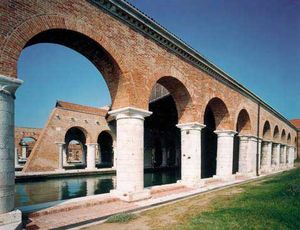Florence has more than its fair share of palazzi. These once opulent residences of the wealthy and noble have been transformed to accommodate the evolving needs of a crowded destination city and now serve as museums, offices, rental apartments, hotels and retail spaces. Expensive to maintain and renovate many have also been left sadly neglected and closed. Currently on the horizon is an unprecedented palatial project offering something different for the city and its visitorsa five star luxury resort!
The Palazzo Bartolomeo Scala or Palazzo della Gherardesca (it has two names; the first being the original owner and the latter the last family proprietor) is undergoing a massive restoration and refurbishment to become the European ‘jewel’ for the Four Seasons Hotel Chain. A Palace of relative architectural and artistic interest it was designed and built by architect Giuliano da Sangallo in 1490 for the Scala family. Classical in design and reminiscent of Brunelleschi, its long, uncluttered geometrical façade fronts Borgo Pinti and wraps onto Viale Matteotti, technically situating it within the historic center. Its integral Renaissance courtyard and graceful logia is resplendent with mosaic floors, elaborate iron work gates and bas-relief arches. Frescoed walls by artists of varying importance peek out from flanking clusters of ante rooms rendering the approach to the Palace’s inner sanctum remarkable. But its most fantastic and unique feature is the 4.5 hectares of private green space it protectively embraces. Truly a rare commodity in this noisy, sepia colored stone city! This combination of greenery and classical grandeur attracted the attention of Italian developers Fingen SpA, the company involved with McArthur Glen outlet malls in Italy. Fingen approached Four Seasons Hotels as a managing partner to realize the concept of a palatial resort, complete with pools, gardens, health club, tea room, bar, restaurants and convention spaces right in the heart of one of Europe’s most visited cities.
The project first met with resistance from both the city and hospitality industry who claimed Florence had enough hotel rooms. The project’s proposal, however, underlined the lack of five star accommodation options alongside the unique features a resort offers. Fingen and the Four Seasons prevailed. The Palace and the neighboring defunct convent of Suor Maria Riparatrice were purchased in 2000.
Renovations are well underway with the intention to open the 118 luxury rooms and 10 exclusive historical suites in early 2007. Restoring a 550 year old Renaissance palace is no easy project. The governmental watchdog agency of the Belle Arti determines what artistic and cultural artefacts need be conserved and how. The palace’s long history is witness to many revolutions of artistic taste and function creating an interesting dilemma of what to save – the unusual and rare wallpapers of the late 19th century or the underlying, earlier yet secondary quality frescoes? As project managers Filippo Calandriello and Guido Pelagallo explain ‘there are a thousand problems a room’. Hence the estimated refurbishment budget currently sits at 90 million euros. Government incentive is small, a possible return of 8% on expenditures directly associated with art restoration. So why take on such a costly project? Fingen regard themselves as ‘caretakers of something beautiful and ensuring the future duration of these assets while still providing public access’.
Fingen is sparing no expense when it comes to the quality of the project, engaging only reputable, proven consultants and experts in its development. Architects Magris and Partners and Studio Noferi e Associati plan to maintain the integrity of the classicized architecture but address the daunting challenges of providing modern technology and services including the addition of 4 elevators. Landscape architect Giorgio Galetti is preserving the original botanical history and statuary but incorporating narrow winding paths to provide guests and staff golf cart access through the extensive 4.5 hectares of gardens. All rooms and common public areas will restore original frescoes, majolica tiles and coffered ceilings providing visitors a 21st-century interpretation of the palace’s historical splendor. Implementing all the details is CPF, a well recognized construction firm boasting a portfolio of high profile projects and demanding celebrity clients.
The Palace’s restoration and commercial function may not please all puritan art historians and art conservationists but the resort project is possibly sparing Palazzo della Gherlardesca from a less glamorous fate and will doubtless catapult it from relative obscurity to the attention of a new ‘nobility’.






